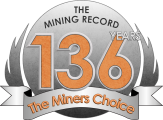Identification Of Porphyry And Skarn Targets At Berenguela Ag-Cu-Mn Project
Identification Of Porphyry And Skarn Targets At Berenguela Ag-Cu-Mn Project
VANCOUVER – Aftermath Silver Ltd. reported on target generation work underway at the Berenguela Ag-Cu-Mn project in southern Peru. The technical team has been reviewing historic field work carried out by previous operators of the project including Rio Tinto (RTZ). Metallurgical test work is also underway on silver-copper-manganese mineralization. Based on a review of historic geophysical data, the Company believes that there is potential for bulk-tonnage porphyry and/or skarn-hosted copper mineralisation approximately 4km to the southwest of the Berenguela Ag-Cu-Mn project. Work is ongoing to further define the targets. Aftermath will also be following up on Hole BED 006, drilled by Silver Standard in 2015 on the northeast corner of the current resource.
In 2018, Valor Resources Ltd. completed a systematic geochemical rock-chip sampling program on a sample spacing of roughly 50m in the southwest of the Berenguela concessions; 198 samples were collected. This program was limited to the west and south by the edge of the Berenguela land package, and to the east by lack of outcrop. There was no evidence of outcropping mineralization to the north and no sampling was carried out there.
The geochemistry defines a broad northwest-southeast linear trending copper-in-rock-sample anomaly, roughly 1km long returning assays from trace to a maximum of 10.9% Cu in rock chips. The results include 22 samples grading in excess of 1% copper. There was a general correlation between Cu, Ag, and Mn but little geochemical response was observed from the gold assays. At the northwest end of the anomalous copper trend, outside of Aftermath’s concessions, an active mine exploits magnetite hosted in altered limestones of the Ayavacas Formation.
Aftermath geologists have confirmed that the northern part of the copper anomaly is located principally in brecciated diorites of probable Tacaza Group age that intrude Cretaceous dolomitic limestones of the Ayavacas Formation, which also hosts the Berenguela resource. Several old workings show copper mineralization (malachite and neotocite Cu oxides) and Mn oxides related to cross-cutting multi-stage quartz veinlets. Altered dolomitic limestones also show Cu and Mn mineralization. Some skarn float was observed to the east. Photos of hand specimens collected from the area have been posted online here and are also included below.
The geochemical results are historical in nature. Aftermath has not yet undertaken any independent investigation of the sampling nor has it independently analyzed the results of the historical exploration work in order to verify the results. However, Aftermath considers these historical sampling results relevant, and the Company will use this data as a guide to plan future exploration programs. The historic analyses were undertaken at SGS Laboratories in Lima via Inductively Coupled Plasma – Optical Emission Spectroscopy (ICP-OES). As part of the QA/QC control Valor inserted 4 standard samples (CDN-HZ-2, CDN-ME-4 and CDN-ME-12), 3 blank samples, and two duplicates. Gold analysis was performed by fire assay at SGS. SGS’s facility in Lima is a fully accredited laboratory and Aftermath believes the analytical results are reliable. The exploration results are linked here. The hand sample photos shown below are for demonstration purposes only and the visual presence of minerals is noted without any grade implied.
The Company recently obtained the results of a comprehensive ground magnetic survey carried out by Rio Tinto (RTZ) in 2019 under the terms of a joint venture with the previous operator, Valor. The survey covers the southern portion of the Berenguela land package and complemented a ground magnetic survey carried out in 2009. RTZ’s geophysical contractors created a Magnetic Vector Inversion model (MVI) using Geosoft VOXI software.
Aftermath has reviewed the MVI model and extracted the Amplitude, Induced, and Remanent components of this inversion. The Induced and Remnant components appear to have identified 2 potential buried intrusive centres in the south and southwest of the Berenguela land. The southwest centre is roughly coincident with the geochemical trend outlined above and appears to be related to the eastern flank of the Limon Verde monzogabbro -dated at 30Ma- which intrudes into the Ayavacas limestones. The Induced component of the magnetic signature suggests the presence of magnetite as an alteration mineral in the intrusives or flanking intruded rocks, whilst the Remnant component suggests the potential alteration of the intruded rocks.




Comments (0)